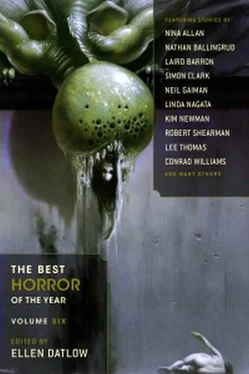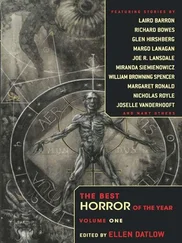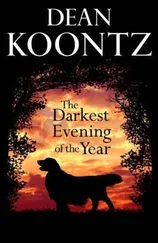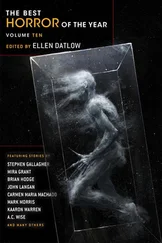She doesn’t like Symes, though, this seems clear to him. Join the club.
“Ashley is my wife,” Symes says. He grins into the face of the woman, a smile of such transparent artifice it is as if both he and she are playing a practical joke at Croft’s expense.
Suddenly, in the overheated room, Croft feels chilled to the bone.
Is Symes serious? Snatches of words and images play themselves across his brain like a series of film stills: Symes’s grin, the woman’s slack features, the sticky word wife .
You’re wondering if they fuck , Croft thinks. Is that all it is, though? He takes another swig of the beer and the thoughts recede.
“Would you excuse me, just for a moment?” Symes says. “There’s a phone call I need to make. I’ll be right back.” He stands and walks away. The woman in the armchair looks after him for a second, then strains forward in her seat and puts her hand on Croft’s knee. Croft can smell her breath, a sickening combination of peppermints and something else that might be tuna fish.
“You know him,” the woman says, and for a moment Croft imagines she’s talking about Symes, though the words that follow make his supposition seem impossible. “Even though you don’t know it yet, you know him. He’ll steep all his children in agony. Not just the agony of knowing him, but true pain.” She tightens her grip on his knee, and Croft realises that she is strong, much stronger than she appears, or than he would have believed.
The mad are always strong, Croft thinks. He does not know how he knows this, but he knows it is true.
“Who are you talking about?” Croft says quietly. “Who is the master?”
The woman leans towards him. Her face is now so close to his that her features seem blurred, and Croft thinks for a confused moment that she is about to kiss him.
He sees himself straddling her. Her mounded flesh is pale as rice pudding.
“He is the tiger,” she says. She grins, and her grin is like Symes’s grin, only, just like the Jesus man, she has a tooth missing. The sight of the missing tooth fills him with horror.
“I need to get out of here,” he says. “I mean, I need to use the bathroom.” The room feels unbearably hot suddenly, stifling with the scent of unwashed bodies. He places his half-drunk beer on the coffee table, and as he makes his way back to the hallway, he finds himself wondering if the woman will take advantage of his absence to taste the alcohol. He imagines her thin lips, clamping themselves around the mouth of the bottle in a wet, round “o.”
He can hear Symes’s voice, talking softly off in another room somewhere, but Croft ignores it. The staircase leads upwards to a square landing, with four doors leading off it, all of them closed. Croft tries one at random, not through any logical process of deduction but because it is closest. By a stroke of luck, the room behind it turns out to be the bathroom after all. Croft steps hurriedly inside and locks the door. He sits down on the closed toilet seat, covering his face with both hands. The room feels like it’s rocking, slowly, back and forth, like a ship in a swell, though Croft knows this is only the beer, which he is unused to. He has barely touched a drop of alcohol since leaving prison. He presses his fingertips against his eyelids, savouring the darkness. After a minute or so, he opens his eyes again and stands up. He lifts the toilet seat, pisses in an arcing gush into the avocado toilet bowl. He washes his hands at the sink. His face, in the mirror above, looks pale and slightly dazed but otherwise normal. It is only when he goes out on the landing again that he sees the photographs.
There are six of them in all. They are arranged in two groups of three, mounted on the blank area of wall at the far end of the landing and directly opposite the bathroom door. He had his back to them before, Croft realises, which is why he didn’t see them when he first came upstairs. He recognises them at once. He thinks it would be impossible for an artist not to recognise his own work. One of the photos is of Murphy, or rather Murphy’s hands, secured behind his back with a twist of barbed wire. The Kennington case. Four of the other photos are also work shots, all photos he took for the Met in the course of his twenty-year career as a forensic photographer.
Lilian Beckworth, a car crash victim.
The Hallam Crescent flat, gutted by fire.
The underpass near Nunhead Station where the Cobb kid was found.
The sixth photo, not a work one, is of Rebecca Riding. The police believed it had been taken less than thirty minutes before her death.
Croft told his lawyer and the police that the photos they found at his house were not taken by him. His camera had been stolen, he said, and then later returned, placed on his front doorstep, wrapped carefully in a Tesco bag. Whoever left it there had not rung the bell. When Croft later developed the film, he found pictures he remembered taking at various sites around Lewisham and Manor Park. He also found the photos of Rebecca Riding.
“The photos are good though, aren’t they, Dennis?” the cop kept saying. “They’re no amateur job. You’re a professional. You remember taking these, surely?”
Croft said he didn’t, and kept saying it. In the end, he could hardly remember, one way or the other.
It was true that they were very fine photographs. He’d spent some time working on them in his darkroom. The excellence of the results surprised even him.
Croft turns away from the photographs and goes back downstairs. In the stuffy living room, they are all waiting, and for a moment, as he returns to his place near the doorway, Croft gets the feeling that he has been lured there on false pretences. He brushes the thought away, sits down on the uncomfortable wooden chair. The hour passes, and at the end of it, Croft cannot remember a single thing that has been said. People are standing, going out into the hallway, pulling on coats. As Croft moves to join them, he feels a hand on his arm. It is Richard Symes.
“Some of us have clubbed together to buy you this,” he says. “Your work means a great deal to us here. We’re hoping this will help you find your feet again.”
He hands Croft a package, a small but heavy something in a red-and-white bag. Croft knows without having to be told that it contains a camera. The gift is so unexpected that he cannot speak. Symes is smiling but it looks like a snarl, and finally it comes to Croft that he has been drugged, that this is what has been wrong all along, it would account for everything.
Drugs in the Bud.
Bennies in the beer.
It’s the only thing that makes sense. Fourboys was right.
Outside, he feels better. The air is cold, bright as a knife. The sensations of nausea and unreality begin to recede. Croft walks smartly away, away from the house, along Sydenham Park Road and all the way to the junction with Dartmouth Road. He stands there, watching the traffic, wondering how much of the past hour was actually real.
The camera is a Canon, a top-of-the-range digital. It is not a hobby camera. Whoever chose it knew exactly what they were getting.
He has given up asking himself why this has been done for him. Having the camera in his hands is like coming alive again. He remembers the dream he had before he was in prison, his idea of giving up the police stuff and going freelance.
He has been taking photographs of the boy, Alexander. They are in the old Leegate shopping precinct just over the road. The boy is in a t-shirt and clean jeans, it is all perfectly harmless. When Croft returns the boy to the pub afterwards, Sandra is behind the bar. There is a complicated bruise on her upper arm, three blotches in a line, like careless fingerprints.
Читать дальше













